Is Theophilus a Ancient Region on the Moon?
Can the Moon's surface hold clues to ancient civilizations? Theophilus is a prominent lunar crater, but it's not an ancient region in the sense of hosting past civilizations. Theophilus is a relatively young formation, sculpted by the cataclysmic impacts that shaped our celestial neighbor.
Editor Note: Theophilus, an intriguing crater on the Moon's surface, is a fascinating subject for exploration and study.
It's important to understand that while the Moon's surface bears the marks of countless impacts, these are geological events, not signs of intelligent life. Understanding this distinction helps us appreciate the Moon's history, not as a cradle of ancient civilizations, but as a testament to the chaotic, violent beginnings of our solar system.
Our Analysis: This exploration dives deep into the geological history of Theophilus, separating fact from fiction. We'll analyze its formation, age, and features, providing insights into its origin and significance.
Key Points about Theophilus:
| Key Point | Description |
|---|---|
| Formation: | Theophilus Crater formed by an impact from a massive celestial object. |
| Age: | Estimated to be around 3.8 billion years old. |
| Location: | Located in the southern highlands of the Moon, near the crater Cyrillus. |
| Prominent Features: | Includes a central peak, a terraced rim, and a system of radiating rays. |
Theophilus Crater: A Window into Lunar History
Theophilus stands as a testament to the Moon's tumultuous past. Its formation, a result of a colossal impact, paints a picture of the chaotic, violent early days of our solar system.
Here's a closer look at key aspects of Theophilus:
Formation
Theophilus's formation is a result of a violent impact event. An asteroid or comet, likely several kilometers wide, slammed into the lunar surface, carving out a massive crater and ejecting debris across a vast expanse. The impact's energy was phenomenal, triggering seismic waves and melting lunar rock, creating the crater's distinctive features.
Age
Scientists estimate Theophilus to be around 3.8 billion years old, placing it within the period known as the Late Heavy Bombardment. During this era, the inner solar system was bombarded by countless asteroids and comets, leaving behind a scarred landscape on the Moon and other celestial bodies.
Features
Theophilus boasts a series of notable features that are common to impact craters. These include:
- Central Peak: A prominent mountain rising from the crater floor, formed by the rebounding of the lunar surface after the impact.
- Terraced Rim: A series of concentric rings around the crater, formed by the slumping and collapsing of the crater walls.
- Rays: Bright streaks of ejecta radiating outwards from the crater, visible from Earth.
Theophilus and the Moon's Evolution
Theophilus is a vital piece of the puzzle in understanding the Moon's history and evolution. Studying its formation, age, and features helps scientists unravel the chronology of impacts and how these shaped the lunar surface.
By analyzing the composition of the crater's ejecta, scientists can also learn about the early composition of the Moon and the objects that impacted it.
Theophilus, despite its impressive size and striking features, is not a vestige of an ancient civilization. It's a monument to the Moon's violent past, providing invaluable insights into the formation of our solar system and the history of Earth's celestial neighbor.
FAQ
Q: Is there any evidence of life on Theophilus or the Moon?
A: No, there is no evidence of any past or present life on Theophilus or any other part of the Moon.
Q: Why is Theophilus significant for lunar research?
A: Theophilus provides critical data about the Moon's early bombardment history, surface composition, and geological evolution.
Q: Can Theophilus be seen from Earth?
A: Yes, Theophilus is large enough to be observed with binoculars or a small telescope under favorable conditions.
Q: Is Theophilus the oldest crater on the Moon?
A: No, Theophilus is considered relatively young. There are numerous craters on the Moon that are significantly older.
Q: Are there other prominent craters on the Moon like Theophilus?
A: Yes, there are many large impact craters on the Moon, such as Copernicus, Tycho, and Clavius. These craters are all vital for understanding the Moon's history.
Q: How does Theophilus compare to other lunar craters?
A: Theophilus's size, features, and age make it a significant crater in lunar studies. It's often used as a reference point for comparing other craters and analyzing their formation processes.
Summary
Theophilus Crater is a fascinating example of the Moon's geological history. While it may evoke questions about ancient civilizations, it's a testament to the impact events that shaped our solar system. Studying Theophilus and other lunar craters provides valuable insight into the Moon's evolution, the early solar system, and the processes that govern planetary formation.
Closing Message: Theophilus reminds us that the Moon is not a static world, but a dynamic celestial body with a rich history. Its craters, like Theophilus, are not mere blemishes but windows into a past of immense energy and transformation.

